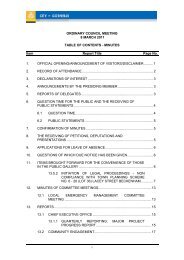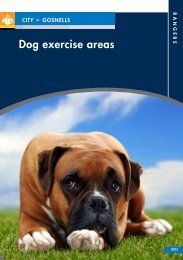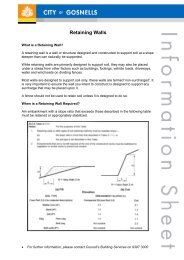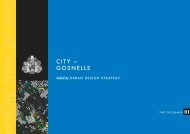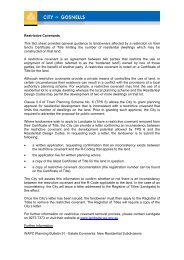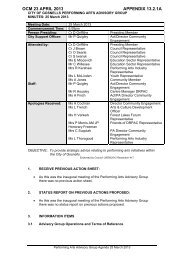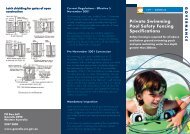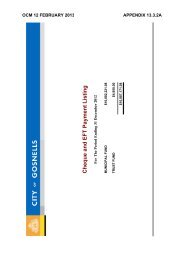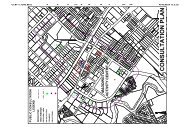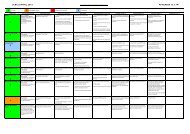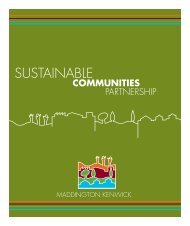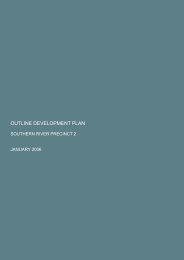Summary - City of Gosnells
Summary - City of Gosnells
Summary - City of Gosnells
Create successful ePaper yourself
Turn your PDF publications into a flip-book with our unique Google optimized e-Paper software.
Wetlands Field Survey 776. Wetlands Field SurveyThe current wetlands survey built on the foundation provided by the mapping <strong>of</strong> Hill et al. (1996). It enabledthe recognition <strong>of</strong> additional wetlands, geomorphic wetland types and wetland values that were notpreviously known in the area. It also provided a fine scale management category assessment for all <strong>of</strong> thewetlands that are mapped as CCW and or REW in DEC (2008a). To complete the wetland assessmentrequired by DEC (2007) for recommendations to amend or modify the SCP Wetlands Dataset, further studyis indicated to delineate wetland boundaries more accurately and characterise factors (such as MucheaLimestone aquifers) that maintain wetlands, particularly along the interfaces <strong>of</strong> the Pinjarra Plain with theBassendean Dunes. As there are complex stratigraphic/hydrological features and threatened ecosystems inthe area, this study should be carried out by specialist wetland scientists with ecological expertise. It shouldalso be at a fine scale that is appropriate to the processes that affect native vegetation and part <strong>of</strong> an overallplan for determining and restoring the environmental water requirements <strong>of</strong> the vegetation <strong>of</strong> the greater area<strong>of</strong> the alluvial fan and increasing the quality and quantity <strong>of</strong> the groundwater in the Yule Brook and BickleyBrook catchments.The MKSEA is part <strong>of</strong> an alluvial fan complex that forms an almost continuous wetland ecosystem thatextends over most <strong>of</strong> Kenwick and Maddington and has been mapped as about 70 wetlands (palusplains,sumplands or damplands) that are identified under Unique Function Identifiers (UFIs) in the SCP WetlandsDataset (DEC, 2008a; Table 6.1). Other wetland types (palusplains and floodplains) that are rarer on the SCPhave also been described at a finer scale in the vicinity <strong>of</strong> the MKSEA (VCSRG, 2001). The system fornumbering individual wetlands using UFIs in DEC (2008a); Figures 9, 10; Table 6.1) is somewhat artificialin the MKSEA (and other areas <strong>of</strong> the Pinjarra Plain) as the boundaries <strong>of</strong> wetlands are not clearly evident inlow relief, predominantly wetland landscapes that are underlain by complex stratigraphy. UFI boundaries insuch areas are largely artefacts <strong>of</strong> the various land uses and cadastral boundaries, whereas the natural wetlandboundaries are, usually, the interfaces between the wetland landscape <strong>of</strong> the Pinjarra Plain and any uplandareas <strong>of</strong> low dunes <strong>of</strong> Bassendean Sands.From the broadscale mapping <strong>of</strong> surface sediments and landforms in Kenwick and Maddington (Jordan,1986; Figure 6) and the climate <strong>of</strong> the SCP, it could be predicted that the only parts <strong>of</strong> the MKSEA area thatare not waterlogged or inundated in winter would be relatively small areas <strong>of</strong> dunes. In the project area, suchuplands all occur in the broadscale soil type S8 (Figures 6, 11) where deep Bassendean Sands overlie themuddy sediments <strong>of</strong> the Guildford Formation. Under the Mediterranean climate that is experienced by<strong>Gosnells</strong> (with a mean rainfall <strong>of</strong> approximately 838 mm per annum) most <strong>of</strong> the flat or gently undulatinglands <strong>of</strong> shallow Bassendean Sands over the Guildford Formation (S10), the clayey sands (Sc) and the sandyclays (Cs) <strong>of</strong> the MKSEA could be expected to be poorly drained. Given appropriate topography, these areason the eastern SCP readily form palusplains (seasonally waterlogged flats), sumplands (seasonally inundatedbasins) or damplands (seasonally waterlogged basins), due to the perching <strong>of</strong> rainwater by shallow aquitards.To database the plethora <strong>of</strong> wetlands on the SCP, DEC (2008b) has allotted a Unique Function Identifier(UFI) to each wetland. This number usually applies to the full natural extent <strong>of</strong> the wetland irrespective <strong>of</strong>cadastral boundaries. An exception to this rule (that applies in the MKSEA) concerns the more extensivewetlands in the dataset (those with an area greater than 70 ha) that are not lakes or sumplands and have beendegraded over part <strong>of</strong> their extent. These are divided into several sections (according to wetland condition)and have a separate UFI for each section. In the MKSEA, although the wetlands in DEC (2008b) are mappedunder a total <strong>of</strong> about 70 UFI numbers, this large number <strong>of</strong> wetlands is mainly a consequence <strong>of</strong> the patchyland use history <strong>of</strong> this area (and subsequent wetland degradation) and not the natural wetland boundaries. Inthis ecosystem, the individual wetland areas that are mapped under separate UFIs are generallyinterconnected by such factors as groundwater flow, subsurface water flows along impermeable layers andchannelled surface water flows (Perth Groundwater Atlas, 2004; VCSRG, 2001).The natural wetland boundaries <strong>of</strong> the MKSEA (including the main boundaries between the wetlandlandscape <strong>of</strong> the Pinjarra Plain and the small upland area <strong>of</strong> the Bassendean Dunes) particularly in the areasthat have been cleared <strong>of</strong> native vegetation, are not sharply marked and are difficult to delineate withoutdetailed hydrogeological studies. This was illustrated in BFS 387, where the wetlands were investigated byVCSRG (2001) using the same principles that they had developed in Hill et al. (1996), but at a finer scale.Tauss, C. and Weston, A.S. (2010). The flora, vegetation and wetlands <strong>of</strong> the Maddington-Kenwick Strategic Employment Area.A survey <strong>of</strong> the rural lands in the vicinity <strong>of</strong> the Greater Brixton Street Wetlands. Report to the <strong>City</strong> <strong>of</strong> <strong>Gosnells</strong>, W.A. Version 18.04.10



